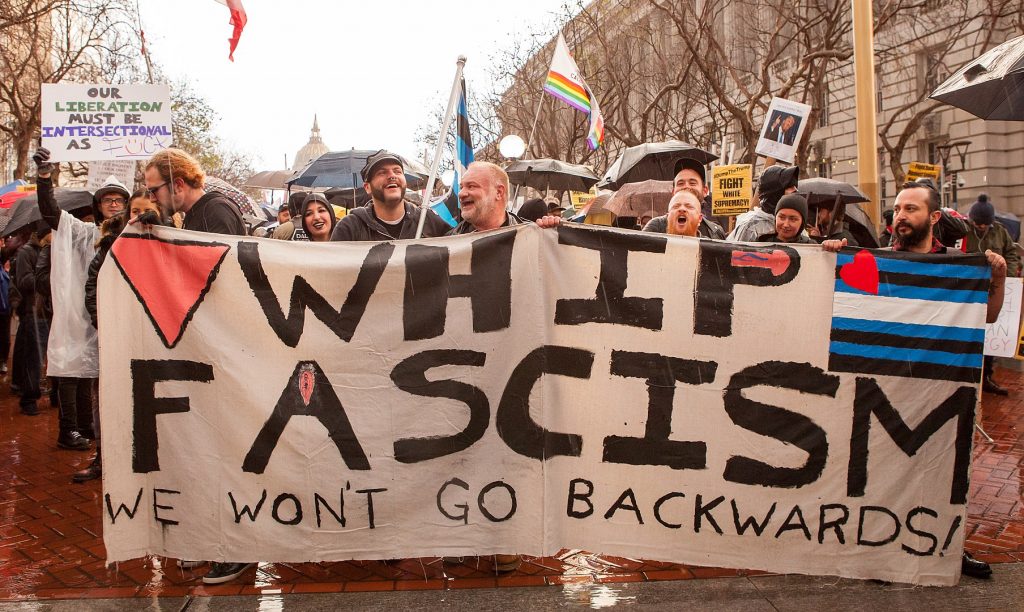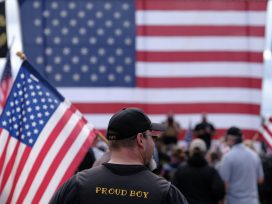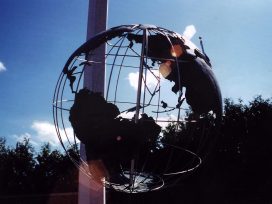James Miller: Since you’ve written an entire book with the title Essays on a Non-Fascist Life, can you tell me a bit about how you chose that title, and what the term ‘non-fascist’ means to you, in the context of those essays? We both know the appearance of the phrase in the context of the work of Gilles Deleuze and Michel Foucault, written in the aftermath of May ’68.
Natasha Lennard: I used the term ‘non-fascist’ as opposed to ‘anti-fascist’ in my title for a few reasons. I wanted to indicate on the book’s cover that this isn’t a collection dedicated wholly to ‘anti-fascism’, as the term is commonly used to describe the radical tactics taken up under the banner ‘antifa’ — that is, the set of (sometimes militant) actions deployed over the last century to expose and disrupt fascist organizing and fascistic forces. The term ‘non-fascist’ also appealed as a (perhaps imperfect) gesture to the complications of ‘anti-fascist’ as a label widely used in communist countries in the decades since World War II. Asserting one’s position as ‘anti-fascist’ became, in many ways, meaningless when even the most far-right, fascistic political groups disavowed the moniker ‘fascist’.
But above all, as you mentioned, I wanted to reference Foucault’s use of ‘non-fascist’ in his preface to Deleuze and Félix Guattari’s Anti-Oedipus (first published in English in 1977) to speak of the sort of intellectual, affective, communal, and emotional work needed to fight ‘micro-fascisms’ and everyday fascisms, or what Foucault called ‘the fascism in us all, in our heads and in our everyday behaviour, the fascism that causes us to love power, to desire the very thing that dominates and exploits us.’
Even at this time of escalating authoritarian practices and policies, from the US, to Brazil, to India, to Hungary, and elsewhere, I maintain that we can and should apply a more capacious understanding of fascism than simply, ‘How much like Mussolini’s Italy or Hitler’s Germany is this?’ Indeed, a narrow focus on the governmental practices of twentieth-century regimes that called themselves or are widely considered ‘fascist’ ignores a lot of the important theoretical work engaged in since 1945. This literature uses the word ‘fascism’, as Foucault did in his preface to Deleuze and Guattari’s book, to describe a set of tendencies, desires, habits, and collective practices that can in fact thrive within capitalist liberal regimes that are ostensibly democratic.
JM: Okay, I get how you like the way Foucault used ‘non-fascist’ in his preface to the English translation of Anti-Oedipus. But I also think it’s noteworthy how quickly he backed away from that kind of overheated rhetoric, and essentially abjured it in his Collège de France lectures in 1976. In his last lecture at the Collège that year, he concluded that the New Left, like Marx, had become far too obsessed with what he called ‘the blood that has dried on the codes of law’. He went on to declare that ‘every time that you have socialisms, or forms of socialism, or moments of socialism that accent the problem of struggle, you have racism. Therefore the most racist forms of socialism have been, of course, Blanquism, the Commune, and anarchism.’
It was remarks like this – obviously hurled as a provocation to the leftist students in his audience – that led Foucault to break off all relations, not just with many of those students, but also with Deleuze, one of his oldest philosophical friends. It was an estrangement, and a political break, that Deleuze described as bitterly painful in a letter he wrote to me while I was working on my Foucault book.
But let’s forget about Foucault for a moment (though I want to come back to his evolving views on political violence later in our conversation). What do you mean by resurrecting the phrase ‘non-fascist’ in our own time? And how would you define ‘fascist’ and ‘fascism’ in your sense of those words?
NL: I’m more interested in an expansive understanding of the term ‘fascism’ that enables us to see fascist tendencies and fascist habits (the love of oppressive power, hierarchy, racism, misogyny). We need to understand how the desire for these tendencies gets fostered and can flourish – on campuses, in the streets, and on social media. Echoing Umberto Eco, I think it’s worthwhile to address ‘fascism’ as – borrowing from Wittgenstein – a ‘family resemblance’ concept. As such, we can name constellations, groups, and regimes ‘fascist’ when they share, in Wittgenstein’s words, ‘a complicated network of similarities overlapping and crisscrossing’.
Indeed, many terms work this way. We use them correctly and meaningfully in the absence of a wholly determinate and always applicable definition (Wittgenstein’s famous example was the term ‘game’). As regards fascism, we might map an overlapping network of similar words – nationalism, racism, traditionalism, chauvinism, an interest in militarism and disregard for reasoned debate – where one or more of them could be absent and yet the term ‘fascism’ might still apply.
Why, you might wonder, should we call something ‘fascist’ if we can simply say ‘racist nationalist’? For me, the term ‘fascist’ does perlocutionary work; that is, it’s aimed at producing a particular effect on the listener. I indicate to the reader/listener that I believe that which I label ‘fascist’ to be deserving of a militant, anti-fascist response.
JM: Fair enough. But now we are back to the phrase ‘anti-fascist’, with all of its peculiar usages on the left after World War II, not least as a term of art deployed by communist governments to justify state violence against anyone they opposed.
And of course, you yourself do use the phrase ‘anti-fascist’ in the first essay in your book, ‘We, Anti-Fascists’, which was originally entitled ‘Anti-Fascist Practice and Impossible Non-Violence’ when it first appeared in Evergreen Review. So you pretty clearly identify yourself with the American activists who act under the banner ‘antifa’.
NL: Now that the US government has made a propagandistic and cynical point of naming ‘antifa’ as its enemy, I see a renewed importance in identifying with the term ‘anti-fascism’; and in that essay I highlight why antifa practices are particularly well suited to fighting the tendencies particular to fascism and its spread.
JM: Say a bit more about what you mean by ‘antifa practices’.
NL: By ‘antifa practices’ I mean the set of tactics typically taken up under the banner of antifa, which are always aimed at creating intolerable consequences for those who would organize toward fascist ends. Much antifa work is dedicated to exposure: exposing, on or offline, the identities of organizing white supremacists and their affiliates, people who regularly use the anonymity provided by online platforms to build followings. Much energy is also devoted to seeing openly white supremacist figures removed from online platforms; this involves alerting YouTube and Twitter that certain figures regularly engage in hate speech that violates their terms of service.
When it comes to more militant interventions – from property damage to physical violence – the choice to use physical force is grounded in an understanding of fascism that holds that debate (which is central to liberal engagement) is an ineffective response. Given that there is no central committee or antifa rule book, there is no way to ensure that every action carried out under the banner ‘antifa’ is well considered, or ethically oriented in its details. That’s a risk, but it’s a risk with any decentralized organizing.
The origins of what we today call ‘antifa’ can be found in the fighting squads who battled against the street gang supporters of Mussolini and Hitler. We see precursors, too, in groups like the 43 Group in Britain: these were Jewish British servicemen who, following World War II, formed fighting gangs to shut down gatherings of anti-Semitic fascists in London and elsewhere. They did not use the term ‘antifa’ to describe themselves. But they deployed tactics we now associate with antifa.
Standard antifa tactics have their limitations, as those who engage in them know. They will not, for example, topple the entrenched and unbroken history of white supremacy in this country by simply breaking up far-right rallies and de-platforming white supremacists. A huge amount of social and political organizing and building is required for that, beyond the work of aggressively confronting the fascists in our midst.
But antifa tactics have been successful in deterring racist organizing in the streets, on campuses, and online. When the Neo-Nazi Richard Spencer cancelled his college tour, for example, he explicitly blamed antifa.
JM: How do you identify a fascist group? What are your criteria for labeling someone fascist? Is a militarized police force ‘fascist’, and therefore a justifiable target of counter-violence?
NL: Antifa does not wait for a group to have every single feature of a traditional, twentieth-century fascist political party to name it as an enemy. There’s no antifa leadership drawing rules about who counts as fascist enough to fight; it’s an ethical practice, not a moral code. It’s worth noting that organized antifa activists have not, in the social media spheres and public protests held under the banner of ‘antifa’, gone after ‘regular’ Trump supporters in their homes or places of work. The proliferation of racist militia groups, like the United Constitutional Patriots on the border, mean that there is no lack of extreme far-right targets. Indeed, when you have groups carrying torches, chanting ‘Jews will not replace us’, and throwing up Nazi salutes, it is odd to be asked, How do you identify a fascist group?
I also don’t think it’s a stretch to use the term ‘fascist” for a militarized police force charged with upholding white supremacy through rounding up and caging immigrants; removing Indigenous people from their lands; or removing Black people from their homes and communities. For this reason, I think the sort of counter-violence we see deployed by participants in the ongoing anti-racist protests is completely valid.
JM: When you speak in your essay on antifa of ‘impossible non-violence’, what do you mean?
NL: When I suggest non-violence is impossible, I do not mean that tactics historically affiliated with principled non-violence should be abandoned tout court; in some contexts, they can be politically effective, especially when it comes to raising a broader public awareness around an injustice.
I mean rather there’s a certain impossibility to invoke a scene of ‘non-violence’ when we’re talking about confronting organized fascism. When protests involve physical fights or property damage the media has a tendency to state that events ‘turned violent’. This applies as much to Black Lives Matter protests, Indigenous struggles against pipelines, or any other movement.
I also take issue with this rhetoric of a violent ‘turn’. There was never a situation of non-violence, or peace, from which to turn. A circumstance in which cops take Black life with impunity, any context in which it is still necessary to state that Black Lives Matter, or Trans Lives Matter, any further assault on the lives and lands of Indigenous people – this is a background state of constant violence.
We can speak of counter-violence, but antifa do not initiate violence, even if at a given event it is an antifa activist who, say, throws the first punch. This is nonetheless a response to a preexisting violence at the scene: the presence and perpetuation of nationalist, paramilitary groups, like the Proud Boys or the followers of Patriot Prayer in Portland, Oregon. They are mindful as well of the ongoing state-supported and racist violence of many local police forces against Black people.
Appeals to truth, reason, fairness, etc., will not break through to groups organized toward white supremacist ends, like Identity Evropa, Patriot Prayer, the Proud Boys, and other racist militia movement contingents. Interventions must instead make their lives as difficult as possible.
JM: Doesn’t the recourse to what you are calling ‘counter-violence’ risk turning into a self-reinforcing, ‘eye-for-an-eye’ cycle of violence and counter-violence? Foucault changed his views on the lust for blood on the far left in the late 1970s in part out of a concern with these risks; and a concern that a preoccupation with violence risked undermining any serious effort to live a life purged of ‘the fascism that causes us to love power, to desire the very thing that dominates and exploits us’.
I am also reminded of Martin Luther King’s views in this context: ‘Our oppressors have used violence. Our oppressors have used hatred. Our oppressors have used rifles and guns. I’m not going to stoop down to their level. We have a power that can’t be found in Molotov cocktails.’
So what do you say to someone inspired by King, or Gandhi, who worries that the tactics of antifa entail stooping down to the primitive moral level of the neo-fascist groups they claim to deplore?
NL: If certain counter-violent acts work against a greater, genocidal violence (that of white supremacy), then I do not think the mere act of taking up arms, or physically fighting, is stooping to their level. This would suggest that the reason neo-fascist groups are immoral is because of their chosen tactics – rather than because they use a variety of tactics to subjugate, dominate, and destroy those they deem ‘other’. We do not differentiate ourselves from fascists simply because some of them are willing to use physical force and we are not.
A person can be inspired by King, or by Gandhi (if they’re willing to overlook his reported anti-Black racism), but I’d also stress that the gains of these movements’ principled non-violence were not won in a vacuum. It takes some pretty selective historiography to ignore the massive riots, like the Watts riots in 1965, that attended the civil rights movement.
Equally, Gandhi’s non-violent movement arose in the wake of decades of violent anti-colonial rebellion in India, from the 1857 uprising to numerous targeted assassinations and attacks against British imperial authority in the late nineteenth century and early twentieth. These political groups were largely crushed during the First World War by British intelligence services. The treatment of the (certainly not non-violent) nationalist Indian National Army after the Second World War is also considered an important turning point in de-legitimizing colonial rule.
Indeed, the history of violent revolutionary struggle is often marked by events where violence was taken up, but in a strikingly measured way. Cedric Robinson noted that in the history of slave rebellions and marronage communities, there was no doubt a reliance on some physical violence to ensure escape and sustain freedom, but a remarkably small number of retributive killings of white enslavers took place.
In any case, I don’t think a defense of struggle that involves violent tactics has to involve ‘lust’ for that violence at all. It might, but I think we need to be able to defend violent tactics without loving them.
JM: But isn’t that precisely the question: whether we can embrace violence without being in some way perverted, even traumatized by our resort to it?
I do think that the Italian fascists and German Nazis were distinguished, in part, by their contempt for compromise and willingness to use force to get their way. And I think what Foucault was driving at is that the counter-violence of the left always runs the risk of aiming to subjugate, dominate, and destroy those who are deemed ‘the enemy’ – and in this way, leftists risk becoming indistinguishable from fascists in their contempt for compromise and willingness to use force.
Nazis and Italian fascists glorified armed struggle and street fighting – and so did the German Communist Party in 1933. Believing they were heroically resisting a post-war version of fascism, the French New Left after May ’68 came very close to emulating the Red Brigade in Italy and the Red Army Faction in Germany by kidnapping people, killing hostages, bombing buildings, robbing banks, etc.
I certainly know from personal experience, in ’68 and ’69, that there is an intoxication to that kind of physical confrontation with the police, a rush of adrenaline, the sense of finding one’s true self in the course of a pitched battle, of facing down the fear of death in noble combat.
But can’t that experience slowly but surely cause us to love power, as Foucault suggests?
NL: I think it remains important not to collapse the potential for experiencing the affective thrill of physical confrontation (which can happen to both those on the right and the left) with the potential for antifa counter-violence to therefore somehow become morally equivalent to fascism. I do think it matters whether destruction is a tactic (say, in the goal of disrupting a Neo-Nazi gathering) or an end in itself (genocide). Besides, history does not provide neat counter-factuals that enable us to conclude that any specific example of tactical counter-violence, say, the armed self-defence of the Black Panthers, added more or less violence to the world.
If the question is indeed whether we can use violence without being perverted by it, I think there are ample historical examples that make clear that, yes, we can.
Does that mean that there is no risk of this? No, of course not, as you point out. Frantz Fanon is clear on that point, too, even while stressing that it is the colonialist who is ‘the bringer of violence’.
But these questions about potential cycles of violence are very thorny. We won’t settle them here.








